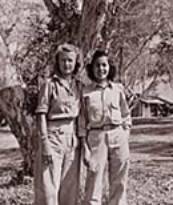Army Nurse Corps History Home > Army Nurse Corps Historical Documentation > Army Nurse Corps Newsletter Historical Articles
ANSWERING THE CALL TO DUTY:
NATIVE AMERICAN NURSES
The people of the United States recognize the monthof November as American Indian Heritage Month. Recently, President George W. Bush stated, 'The strength of our Nationcomes from its people. As the earlyinhabitants of this land, the native peoples of North America played a uniquerole in the shaping of our Nation's history and culture.' During this month, we are reminded that there is a great deal to learnabout the history and heritage of the Native American peoples of our nation.Native American veterans have served and continue to serve their country withpride. Many have heard about IraHayes, a Pima Indian, who was one of the men to raise the flag on Iwo Jima, orhave seen the recent movie illustrating the story of the Navajo code talkersutilized during WWII. Likewise,Native American nurses have served their nation with honor within the Army NurseCorps.
As early as the Spanish-American War, NativeAmericans contributed to the defense of their country. In 1898, it is historically documented that four Native American CatholicSisters from Fort Berthold, South Dakota worked as nurses for the WarDepartment. These nurses begantheir work at a military hospital in Jacksonville, Florida but were soontransferred to Havana, Cuba. Sister Mary Anthony, one of these four women, diedof complications related to Tuberculosis and is buried in Cuba. These nurses were awarded the Cross of the Order of Spanish-American WarNurses for bravery and heroism in the hospital and on the field whileministering to the wants of the soldiers in the Spanish-American War.

(On the Right) First Lieutenant Julia NashannayReeves
In a comparable spirited manner, Julia HelenNashannay Reeves served in the Army Nurse Corps. On a scholarship provided by the Daughters of the AmericanRevolution, Ms. Nashannay Reeves, a member of the Potawatomie Indian Tribe ofCrandon, Wisconsin, completed her nursing training at the Pennsylvania Hospitalin Philadelphia, Pennsylvania. InJanuary 1942, following the bombing of Pearl Harbor, Ms. Nashannany Reevesjoined the Army Nurse Corps as a 2nd Lieutenant. She was assigned to the 52nd Evacuation Hospital in NewCaledonia. The 52ndwas one of the first hospitals activated at the onset of WWII. The unit left in such a hurry that many of the staff were withoutuniforms or had been issued the incorrect uniforms. The Red Cross on the journey through the Panama Canal supplied the nursesattached to the hospital with summer clothes. Prior to the invasion of Normandy,Julia served several weeks' temporary duty on the hospital ship Solace. In 1943, shewas transferred to England where she served with the 23rd StationHospital in Norwich. Julia servedthrough V-J Day.
Upon return to the United States, Julia was honorablydischarged. She attended SimmonsCollege in Boston, Massachusetts where she studied Public Health Nursingutilizing the GI bill. During theKorean War, Ms. Nashannay returned to active duty and served with the 804thStation Hospital that operated at a hospital in Battle Creek, Michigan. Here she met and married Joseph Reeves, a military officer. She was discharged as a first lieutenant. Ms. Nashannay Reeves supported her husband through his military career.They raised four children and retired in the Suffolk, Virginia area. Julia Helen Nashannay Reeves died on the 9th ofMay 1998 at her home in Suffolk. Herhusband recalls that at one time, Julia received an eagle feather from thePotawatomie Indian Tribe as recognition of her service as a warrior for hernation.
These are just two brief historical examples of contributions thatNative American Army Nurse Corps officers have made. Certainly, countless more documented stories of NativeAmerican nurse patriotism and self-less service exist. The Army Nurse Corps Historical Collection has other information andpictures regarding the service of Native American Nurses within the Corps. LTC (Ret) Brenda Finnicum, a former Army Nurse Corps Officer and a NativeAmerican, has completed significant research on Native American nurses. Sinceher retirement she has continued her documentation and research of AmericanIndian women in the military. LTC (Ret) Finnicum has contributed multiplepublications and presentations on this subject.
Fromthe Spanish American War to the current War on Terrorism, Native American peoplehave contributed to our nations defense as members of the Army Nurse Corps. Taking the time to learn about the unique legacy of the NativeAmericanNurse benefits all Army Nurse Corps Officers. The Army Nurse Corps drawsstrength from its members just as our nation's strength comes from its people. Army Nurses: Ready, Caring, Proud!
Historical Data located at the Army Nurse CorpsCollection, United States Army, Office of Medical History, Office of the SurgeonGeneral, Falls Church, VA.

